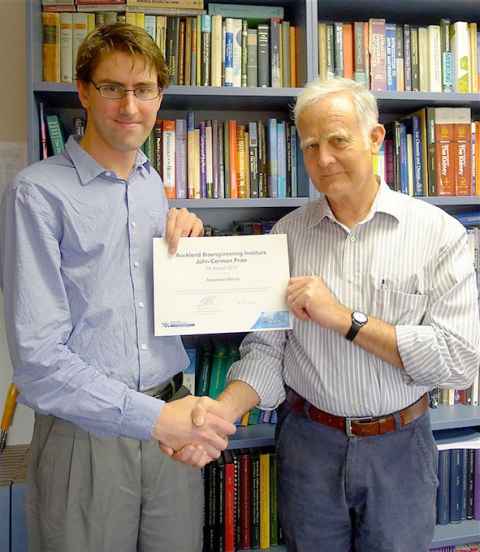Heart failure research wins award

Originally published: 18 September 2013
A presentation on the structure-function relationship in heart failure by Alexander Wilson has won the Auckland Bioengineering Institute’s John Carman prize.
The annual prize is awarded for the best oral presentation by a graduate student at the New Zealand Medical Sciences Congress (an annual event in Queenstown), in the areas of biomedical engineering, computational physiology and/or biophysics.
Alexander’s oral presentation was chosen from those given by five other finalists at the MedSci Congress in late August. He was unable to attend the dinner award ceremony at the conference, and so his prize was recently presented by Professor Peter Hunter, Director of the Auckland Bioengineering Institute (ABI).
The prize honours the lifetime achievements of Emeritus Professor John Carman, who was the foundation Professor of Anatomy at the University of Auckland’s School of Medicine. He was one of the first people at the University to believe the use of numbers would enhance medical knowledge.
Professor Carman died last year, but along with Professor Hunter, made the inaugural presentation of the award in 2010 to Peng Du, another graduate student at the ABI.
“John Carman was a unique and wonderful individual, a passionate anatomist with a penchant for engineering,” says Professor Hunter. “John very early on recognised the potential of computational anatomy and physiology to improve medical outcomes. His support greatly helped the growth of bioengineering as a discipline in New Zealand.”
Alexander is in his first year of a PhD in Bioengineering and is using computer modelling to better understand heart failure. His supervisors are Associate Professor Ian LeGrice from the Department of Physiology and Professor Martyn Nash from the ABI.
“In my PhD project the outcome we are seeking is to provide insight that will lead to effective treatment of diastolic heart failure. Currently there is no effective treatment of diastolic heart failure,” he says.
“Most of the work so far is using small animal MRIs to investigate a rat model of heart failure,” says Alex. “I’m looking at what are the important aspects of the changes in the heart structure in different types of heart failure.”
“I’m examining total collagen and heart mass, and if it is a combination of these, or a subset of these that causes heart failure,” he says. “By making these models, we can test each component of heart failure, such as how stiff the heart wall is or how the ventricles are affected by heart failure.”
Alexander has a Bachelor of Science in Biomedical Science, which he followed with a Postgraduate Diploma in Science (Medical Science), and then a Master of Operations Research with First Class Honours. All were from the University of Auckland.
After working for six months in the energy sector, Alexander realised that he wanted to continue his studies in biomedical science, and embarked on a PhD in Bioengineering with the ABI.
“I could have had a faster journey, but this means I have studied a good variety of subjects related to my research now,” he says.
The following is the abstract for Alexander’s winning oral presentation at the MedSci Conference.
Structure-function relationship in heart failure
Heart failure (HF) occurs when the function of the heart is limited and is unable to pump sufficient blood to meet the body’s requirements. During development of HF changes occur in the structure of the myocardium which is termed cardiac remodelling. HF has conventionally been characterised by impaired contractile performance. It is now known that equal numbers of patients with HF symptoms have normal contractile function but impaired diastolic function (filling) and for this form of HF conventional treatment is largely ineffective. New treatment approaches are required for these patients. These will be informed by a detailed understanding of the effects of structural remodelling on cardiac function. This understanding will be gained by combining measurements of structure and function within a modelling environment.
We use the spontaneously hypertensive rat (SHR) as an animal model of HF as it progresses through diastolic to systolic dysfunction. Groups of untreated SHRs at various stages of HF are compared with both ACE inhibitor treated SHRs and control rats. Functional measures are obtained from cine MRI, revealing global deformation, ejection fraction and relaxation times. In vivo left ventricular pressures are measured concurrent with MR imaging and measures of passive ventricular compliance are obtained in the isolated heart. Additionally, MRI tagging studies will allow a 3D kinematic analysis of local longitudinal, circumferential, radial and ventricular torsional strains. Cardiac microstructure is imaged utilising extended volume confocal microscopy which reveals laminar arrangement and collagen structure. These measures combine for a rich data set which will aid development of new computer modelling tools including ventricular finite element models and material constitutive equations.